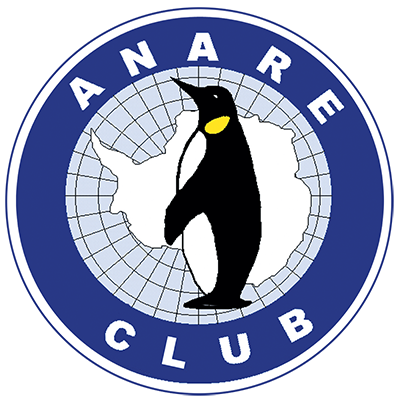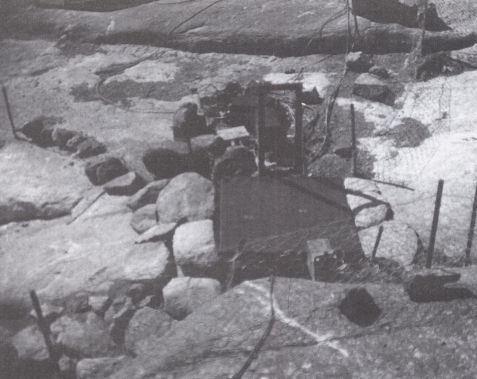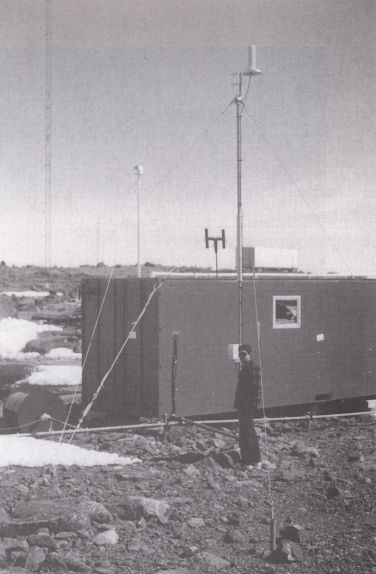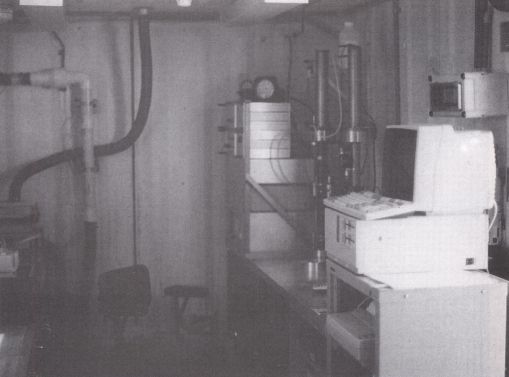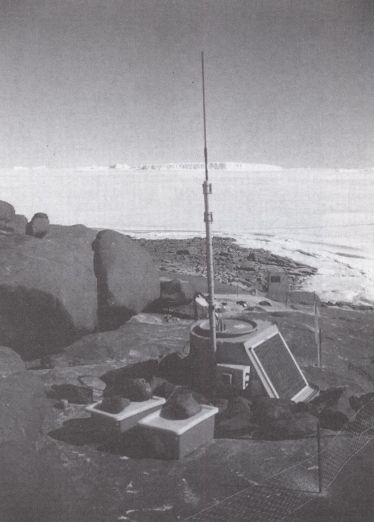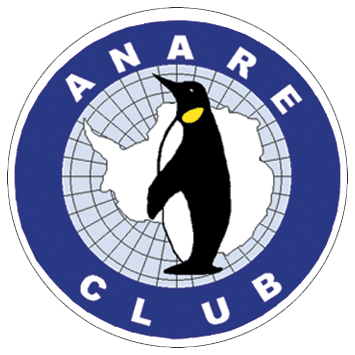John Zmood ANARE Club representative Aurora Australis Voyage 4 1993 – 1994
Antarctic Boffining – A Retrospective
As I peered through the porthole into the gloom of a rainy Hobart afternoon on the Derwent River I reflected on what Rex Moncur (the Director of Antarctic Division) told the expeditioners. Science is why we are in Antarctica. In particular, that part of scientific endeavour which supports the management of the Antarctic wilderness is the reason why we are there. What a change from the debate of twenty years ago when I first made the trip to Antarctica. Then the broadly held view seemed to be that if we were going to occupy the place we might as well do some science to fill in the long nights of the Antarctic winter. Explore, map, rock-hop and find worthwhile prospects for future mineral exploitation of course, look and see new physical phenomena and even find curious biological entities but remember justifying our claim is what it is all about. As I was soon to find out, a change of attitude was not the only change that has taken place in the last twenty years. The “doing of science” in Antarctica has really changed.
I think the first inkling I had that things were going to be different was when the Division demanded that I sign the “ANARE Code of Conduct”. On my scout’s honour I had to promise to behave and not damage the Antarctic environment. The second inkling came when I opened the ANARE field manual and found that each station was surrounded by an “invisible fence” – the station limits beyond which no expeditioner could go without permission. Then there were the areas marked “SSSI” or Sites of Special Scientific Interest that required an access permit from Australia. It seemed as if a boffin was going to need a “gaggle” of Queen’s Councils, a supply of Environmental Acts, and a mobile radio link to the “Internet” super-highway to ensure there was no possibility of infringement of Australia or international law.
The flavour of science seemed to have changed too. No longer were boffins looking to see what might be there. The exploratory phase of science was over. Programmes were now directed research. Antarctic research was no longer of interest to just a few boffins. The “hole in the ozone layer”, global warming and climate change, the biota of the southern oceans had put Antarctic research at the focal point of public concern. “Laboratory Antarctica” had come of age.
To understand the workings of “Laboratory Antarctica” there is a need to be aware of some of the changes that have taken place. Firstly there is a new legislative environment that regulates all human activity in Antarctica. Secondly the scientific questions are different to those of twenty years ago. Thirdly the regime for the conduct of scientific research is different especially in respect to “in-house” research vis-a-vis externally sponsored research. Other changes have taken place as well. Funding, staffing, equipment, logistic support, communications, boffin comfort, etc, have all improved significantly to meet the challenge of increased scientific productivity.
For those who want the detailed explanation of this metamorphosis a quick read of the report “A Report of the Antarctic Science Advisory Committee June 1992 – Antarctic Science The Way Forward: by the Department of Arts, Sport, the Environment and Territories gives a guide as to where all this is coming from.
We are all aware our hapless huskies had to become refugees as a result of a certain treaty meeting in Madrid which “saved” Antarctica. Only the privileged few understand the full implication of this treaty and the consequent Australian legislation. For the first time it was now possible to protect scientific sacred sites from the marauding Antarctic invaders.
Previously only biological sites were protected. From the boffin’s point of view this is a mixed blessing. Certainly the sites are protected but if one believes the hushed voices of the modern boffin, the bureaucracy associated with gaining access to the sacred sites can result in significant delays. These delays could impose a significant cost of the amount of research that can be undertaken by the summer boffin.
Not to be outdone by our treaty obligations the regulators devised a more insidious law, the Occupational Health and Safety Act. A more frustrating enactment could not have been devised. It would seem its sole purpose is to prevent boffins from boffining. With this enactment it would seem that the only activity allowed to anybody in ANARE is the playing of computer games in the warm cocoon of the station buildings, provided you don’t become too excited and risk the government having to pay out for stress related compensation claims. This “Gulag mentality” would appear to be the explanation for the “invisible fence” on the station maps. Certainly the “mind police” make it very apparent that “A” for Adventure is politically “incorrect think” in today’s ANARE. The result of all this legislation is a plethora of manuals, guidelines, and other documentation. To think that I once believed that Antarctica was treeless becauise of the tilt of the earth’s axis. I suspect a proper scientific investigation of the matter would show that the scientific sacred sites for which no permit will ever become available hid the foundations of giant paper mills which were necessary to produce the paper upon which the enactments were published.
Gone are the days of monitoring a few basic parameters and calling that science. Australia’s Antarctic research is now more focussed and better organised.
As Rex Moncur stated, the mission statement for Antarctic research relates to understanding the Antarctic from the point of view of managing a world asset and using “Laboratory Antararctica” to develop an insight into global phenomena such as “global warming”.
The Australian National Committee on Antarctic Research report to the Scientific Committee for Antarctic Research (Number 35-1993) describes nearly 200 research projects involving over 124 principal research workers in fields as diverse as biology, atmospheric sciences, engineering, environmental studies, geodesy and geographic information, geosciences, glaciology, human biology and medicine, oceanography, and social sciences. If for no other reason other than to gain an insight into how much effort is being put intoANARE’s scientific programmes, the report is worth more than a cursory glance.
For my part, as a former Upper Atmospheric Physicist, it was noteworthy that the UAP programme was studying energy exchange phenomena at altitudes somewhat lower than the auroral electgro-jet. The current work is being conducted with a view to better understanding the relationship between the upper atmosphere and climate.
While the journalists’ minds are grappling with minor phenomena such as a hole in the Ozone layer and the need for better suntan oils, the real boffins are trying to understand the mechanisms of global climate change and the consequences of the release of “greenhouse” gases. The interaction between the Antarctic icesheet, the Antarctic atmosphere, the surrounding Antarctic oceans and their biota in the equation of life has forged new boffin alliances and raised many new questions for study. Boffinry has become a much more interesting game to be in than it was in the mono-disiplinary days of twenty years ago. In some sense the rest of the world is catching up with what we expeditioners already knew; Antarctic research is important to the welfare of the world.
To go with this new mission, a number of new institutional arrangements have been put in place. The old players are still there of course, the research section of the Antarctic Division, Bureau of Meteorology, Ionospheric Prediction Service, the Australian Geologicay Survey, CSIRO, and the various Universities, etc. New organisations such as the Institute of Antarctic and Southern Ocean Studies and the Cooperative Research Centre for the Antarctic and Southern Ocean Environment have evolved to support the new multi-disciplinary focus.
The funding of research has changed also. In the old days most projects were supported out of the Antarctic Division’s budget or that of the sponsoring government departments. Today the Antarctic Science Advisory Committee Grants fund specific projects with the Antarctic Division providing logistic support.
Another interesting change is the employment contracts of the boffin expeditioner. Twenty years ago boffins were Commonwealth employees albiet temporary exempt ones. The Commonwealth is still an employer but the new arrangements provide for research students and unpaid volunteers to be part of ANARE.
The accommodation and field site facilities provided by the Antarctic Division today bear no resemblance with those provided twenty years ago. Today’s composite “apples” and “melons” with their spacious, drift-free, work space and high-tech, equipment facilitate experiments that would never have been considered if they had to be carried out in a polar pyramid tent.
The field equipment, clothing and especially the on-site field training means that Antarctica is becoming more accessible to the new world boffin. No longer is it necessary to be an experienced mountaineer. One’s research skills are more important. The effect of this approach has been to attract boffins who would otherwise have been denied access to Antarctic research. In the end the quantity and quality of Australian Antarctic research will show the merit of this new approach.
Perhaps the most interesting aspect of the change in boffinry in the intervening years has been the advent of satellite communications to Antarctica. Communications and the ability to keep up with what other boffins are discovering has been perhaps one of the main disincentives for boffins spending a year away from their academic environment. Today, with the satellite connection, and the internet network, a boffin can maintain contact with his colleagues, have access to current papers, even submit papers to conferences, etc. the tyranny of physical isolation is no longer such a large disincentive as it once was.
The dark side of the communications revolution is the concept of robot experiments. It is now possible to remotely control experiments to the point where the experimenter no longer needs to be in Antarctica. Satellite technology and the computer network can telemeter all the necessary measurements back to a warm laboratory anywhere in the world. The experiment can be reconfigured by sending a few instructions over the computer network. All that is required is a team to install the equipment and a visit by the technical staff once a year to service it. This is not science fiction, the cosmic ray laboraty at Mawson is unmanned. Upper atmospheric physics and geophysics are going this way too. While this arrangement would give Antarctic access to many a boffin who for reasons of time and more pressing duties could not afford the journey. I cannot help feeling that important discoveries will be missed by those who undertake Antarctic research without actually being there.
There are many other aspects of Antarctic boffinry that could have been addressed in this article: the technical facilities available at the stations and the good ship RSV “Aurora Australis” to name but two. These subjects ought to be told by those who were responsible for implementing them.
No matter where I draw the line, the fact remains there is no doubt that the “doing of science” in Antarctica has changed in the last twenty years. To what extent these changes will result in a better management of the Antarctic wilderness or help resolve the issues of global warming will only be found out with the passage of time. Certainly the Antarctic Division has gone a long way to try and remove the “adventure” from Antarctica but it has also gone a long way to making the continent more attractive to boffinry. My view is however that the biggest attrction of boffinry to Antarctica will be the interesting questions still to be investigated. It will be the quality of the scientifric programmes and not the creature comforts or the lack of danger which attract the boffins to Antarctic research.
Despite my view that the government may have placed too much emphasis on trhe stations and not enough on the funding of research, Australia’s Antarctic research is advancing at a great pace and the Australian taxpayers are getting excellent value for the pittance they are contributing to it.
The Author is grateful to the Antarctic Division and the ANARE Club for the opportunity to revisit Antarctica as the ANARE Club representative on the 1993-1994 voyage 4 aboard the RSV Aurora Australis.
